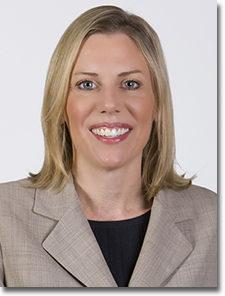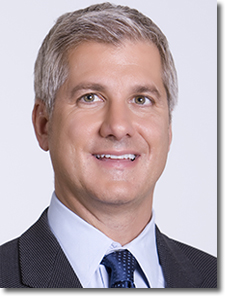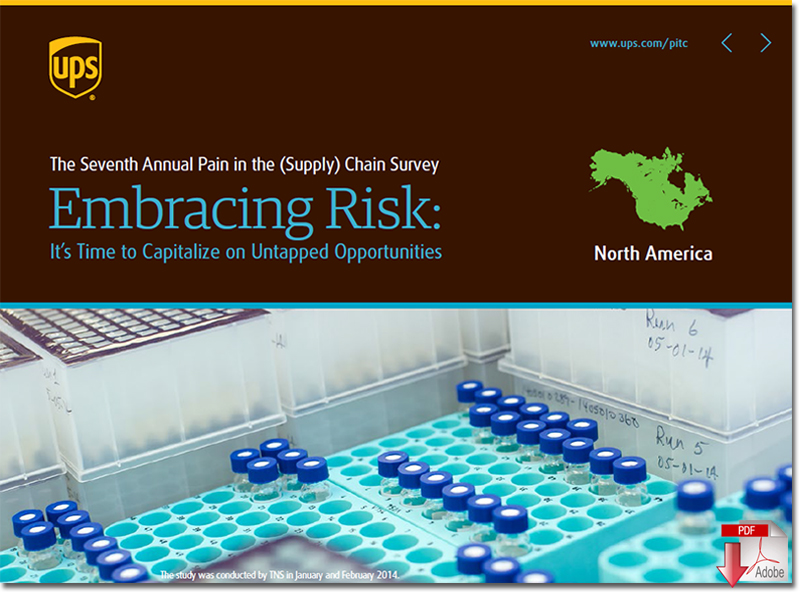UPS’ Pain in the Supply Chain Survey Finds Healthcare Shippers Have Strategies in Place
Globally, healthcare executives are planning for strategic partnerships and technology investment to mitigate risks and capitalize on growth opportunities.
As a sector with myriad moving parts, coupled with obstacles like increased risks, cost pressures, among others, the healthcare supply chain is replete with uncertainties.
But there are ways for the sector to counter these challenges, too, according to the seventh annual UPS “Pain in the (Supply) Chain healthcare survey, which was conducted for UPS by TNS, a provider of global market research services.
Research was based on data and feedback from more than 530 senior-level healthcare supply chain decision makers in the United States and Canada, Western Europe, Asia, and Latin America in the pharmaceutical, medical device, and biotech sectors.
According to the survey, the top two concerns globally among respondents, whom are senior decision makers responsible for supply chain and logistics in their respective sectors, were:
1. Regulatory Compliance at 60 percent and
2. Product Security at 46 percent
Rounding out the top five were:
3. Managing Supply Chain Costs at 44 percent
4. Contingency Planning at 26 percent, and
5. Product Damage or Spoilage at 40 percent.
Other concerns cited by respondents were access to global markets or new customer bases, visibility, and changing distribution and go-to market channels.

UPS Global Healthcare Strategy Director Melanie Alavi said it was not surprising to see regulatory compliance heading that list as it is such an enormous driver of everything within the healthcare supply chain, with it being the top concern in the survey for the third straight year.
“It has also been the biggest driver of change,” she explained. “In an environment of regulatory complexity, in some cases, people have been more willing to say ‘OK, not knowing how this regulation will pan out, let me wait and see before I act.’ That could be contributing to why real industry change has been slow. While stated objectives and plans do exist among the respondents to make change in their supply chains, real change has been slow to be made.”
Another key finding was that even though the economy is slowly improving, the aftereffects of the recession still linger in the form of tightened spending, reductions, and cutbacks, with 54 percent of healthcare supply chain executives in North America and Latin America, respectively still dealing with the recession’s economic blowback, and 46 percent and 43 percent, respectively, in Asia-Pacific and Western Europe expressing the same sentiment.
As for how the economy is impacting the healthcare supply chain, Alavi noted that declining reimbursement levels coupled with the recovery, can be a challenge for healthcare companies. But, she added that there has been a helpful shift with the Affordable Care Act providing healthcare services for a larger number of people who need it, also creating a bigger market of consumers for the industry.
While the regulatory roadmap creates its own host of challenges in the healthcare supply chain, cost pressures are never far from top of mind. That was evident once again in this year’s survey, even though concern over cost management has gradually declined in recent years, with 44 percent of respondents citing it as a top issue, compared to 51 percent in 2013, 60 percent in 2012, and 64 percent in 2011.
And the top three cited strategies for healthcare shippers to manage costs cited in the survey were logistics and distribution partnerships at 78 percent, IT investment at 66 percent, and outsourced transportation management at 62 percent.

Alavi said the number of mergers and acquisitions within the healthcare supply chain can result in companies subsequently not having inventory in the right place or redundant distribution centers, while simultaneously incorporating and adding on an extra company and legacy supply chain into an existing one. She added that these mergers are happening in the industry at a fast rate, making it difficult for them to map things out efficiently.
“We often talk to customers about things like where they have distribution centers and current inventory, the priority markets for their product demand, and how we can create cost efficiencies in their supply chains,” she said. “This can be done by moving a partially utilized DC of their own to an outsourced shared location, where they then pay variable costs for distribution.. This is where they are turning to a 3PL and looking at a shared cost model. At UPS, we have the healthcare-compliant space to manage it, which can be attractive to a shipper.”
Given the number of risks in the healthcare supply chain, contingency planning for the healthcare supply chain ranked somewhat low as a chief concern among the survey’s respondents, with 26 percent citing it as a top supply chain concern. The survey found that specific challenges to addressing business continuity included unplanned events requiring contingency planning being too unlikely or infrequent at 61 percent, back-up infrastructure too expensive to deploy, and little to no prioritization given to this area, at 42 percent, compared to other more urgent matters.
For those healthcare shippers that are having success in mitigating risk and increasing competitiveness, UPS found that many are leveraging partnerships along with investments in technology with: 78 percent pointing to logistics and distribution partnerships as a top strategy to manage supply chain costs; 65 percent using logistics and distribution patterns to successfully access global markets; 61 percent using collaboration, including vested logistics and distribution partnerships, to successfully embrace new distribution and go-to-market channels, and 23 percent leverage M&A activity to do so; and 59 percent working with a 3PL as a top strategy to increase efficiencies and improve competitiveness.
“Companies that embrace new technologies and transformative supply chain strategies to mitigate risks will be more likely to capitalize on new growth opportunities in the healthcare marketplace of tomorrow,” said John MennaJohn Menna, UPS vice president, global healthcare strategy, in a statement.
Press Release
UPS Survey: Time to Act on Untapped Opportunities in Healthcare Industry
Successful companies embrace technology and partnership strategies to manage risk and take advantage of opportunity
An environment of increasing risks, complex regulations and continuing cost pressures is impeding healthcare executives from moving quickly to seize untapped industry opportunities, according to the 7th annual UPS “Pain in the (Supply) Chain” survey. Globally, healthcare executives are planning for strategic partnerships and technology investment to mitigate risks and capitalize on growth opportunities.
The most significant factors contributing to uncertainty in the healthcare supply chain are more stringent regulations and increased product protection challenges. For the third consecutive year, regulatory compliance is the top supply chain pain point, cited by 60 percent of respondents. Further, 78 percent cite regulatory compliance and increasing regulations as a top trend driving business and supply chain changes. Product protection also is increasingly challenging in a highly global marketplace, with 46 percent citing product security as a top challenge and 40 percent citing product damage and spoilage as a top concern.
Economic factors are also at play, with 49 percent of those surveyed still feeling an impact from the economic downturn six years later. The highest percentage of respondents to express this are located in the U.S., where 60 percent of healthcare logistics decision makers cite economic concerns. In this global economic environment, cost management remains top-of-mind, with 44 percent citing it as a top supply chain concern.
Despite operating in a risk-inherent environment, only 26 percent of healthcare executives cite contingency planning as a top supply chain concern. Meanwhile, 34 percent of those surveyed in Asia and 22 percent in Latin America say that more than one-quarter of their companies’ supply chains were impacted by unplanned events in the past three to five years. Specific challenges to addressing business continuity include events being too unlikely or infrequent (61 percent), back-up infrastructure being too expensive to deploy (46 percent) and little to no prioritization being given to this area (42 percent) versus other more urgent matters.
“Companies that embrace new technologies and transformative supply chain strategies to mitigate risks will be more likely to capitalize on new growth opportunities in the healthcare marketplace of tomorrow,” said John Menna, UPS vice president, global healthcare strategy.
Successful strategies for risk mitigation and increasing competitiveness
Of those companies that are successful in mitigating risk and increasing competitiveness, the majority are leveraging partnerships along with ongoing technology investments. Of logistics decision makers surveyed worldwide:
- 78 percent cite logistics and distribution partnerships as a top strategy to manage supply chain costs
- 65 percent use logistics and distribution partnerships to successfully access global markets
- 61 percent use collaboration, including vested logistics and distribution partnerships, to successfully embrace new distribution and go-to-market channels, while 23 percent use mergers and acquisitions to do so
- 59 percent are working with a 3PL as a top strategy to increase efficiencies and improve competitiveness
Again this year, investing in new technologies is a top strategy to increase efficiencies and competitiveness for the next five years. Globally, over the next three to five years, 80 percent of respondents say they will invest in new technologies.
Untapped opportunities in the healthcare supply chain
Despite progress in addressing industry challenges, opportunities remain. One of these areas is in leveraging new distribution channels and models to meet changing customer demands as e-commerce, urbanization and home healthcare grow. Over the past two years, 70 percent or more of those surveyed both years have indicated that they plan to increase their usage of new distribution channels, yet over this same time period their channel mix remains nearly identical. This demonstrates that while the intention to take advantage of untapped opportunities is apparent, actual change is slow. Among the reasons for the slow shift, 68 percent say they are still building their direct channel strategies.

The rise of home healthcare is taking off with growth surges expected over the next decade. Globally, 21 percent of survey respondents cite the shift to home healthcare as a key trend driving business and supply chain changes. Respondents report that 30 percent of products will support the home healthcare channel in the next seven to 10 years.
Another area with untapped potential is collaborative partnerships. In 2011, 62 percent of decision makers surveyed cited working with or increased reliance on a third party logistics provider as a top strategy for the next few years, with 60 percent citing it as a successful strategy over the past 18 months. According to this year’s findings, 59 percent cite it as a strategy over the past 18 months and also over the next few years, indicating that while the healthcare industry recognizes the importance of implementing these strategies to increase competitiveness, companies are slow to act.
Global market expansion is another area in which healthcare companies are heavily investing that continues to hold new opportunities. Over the past 18 months, 65 percent have tapped into new global markets to expand their customer base in order to drive new revenue growth. Looking ahead, 78 percent will expand to new global markets over the next three to five years. These responses closely mirror 2011 survey data, when 81 percent of executives reported they plan to expand to new global markets over the next few years.
“More change is coming in the healthcare supply chain,” said Dirk Van Peteghem, UPS vice president, healthcare logistics. “At UPS, we work to stay ahead of evolving industry trends and develop innovative solutions for our customers based on our extensive expertise, infrastructure and best-in-class technology. Our unique solutions-driven approach gives companies a new level of agility to advance business goals while enabling regulatory compliance and prioritizing product protection and customer service.”
Survey Methodology
The 2014 UPS Pain in the (Supply) Chain survey was a blind, in-depth phone survey conducted by TNS, on behalf of UPS, of more than 530 healthcare executives in the U.S. and Canada, Western Europe, Asia and Latin America. Qualified respondents were senior-level decision makers responsible for supply chain and logistics in the pharmaceutical, medical device and biotech industries. Surveys were conducted between January and March 2014.
Download: The Seventh Annual UPS Pain in the (Supply) Chain Healthcare Survey
Related: What Does Increasing Regulatory Oversight Mean For The Pharma Supply Chain?














